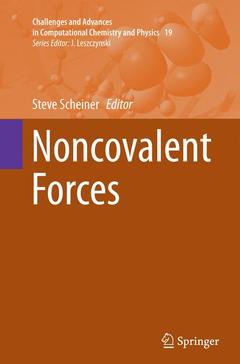Description
Noncovalent Forces, Softcover reprint of the original 1st ed. 2015
Challenges and Advances in Computational Chemistry and Physics Series, Vol. 19
Language: English
Subjects for Noncovalent Forces:
Publication date: 10-2016
Support: Print on demand
Publication date: 05-2015
532 p. · 15.5x23.5 cm · Hardback
Description
/li>Contents
/li>Biography
/li>Comment
/li>
Computational methods, and in particular quantum chemistry, have taken the lead in our growing understanding of noncovalent forces, as well as in their categorization. This volume describes the current state of the art in terms of what we now know, and the current questions requiring answers in the future. Topics range from very strong (ionic) to very weak (CH--?) interactions. In the intermediate regime, forces to be considered are H-bonds, particularly CH--O and OH--metal, halogen, chalcogen, pnicogen and tetrel bonds, aromatic stacking, dihydrogen bonds, and those involving radicals. Applications include drug development and predictions of crystal structure.
1. Introduction to the Volume, Steve Scheiner.- Part 1. Hydrogen Bonds.- 2. Hydrogen bonds involving sulfur: New insights from ab initio calculations and gas phase laser spectroscopy, Himansu S. Biswal.- 3. CH∙∙∙π interaction in organic molecules, Osamu Takahashi.- 4. CH∙∙O H-bond as a determining factor in molecular structure, Steve Scheiner.- 5. Hydrogen bonds involving radical species, Qingzhong Li and Hai-Bei Li.- 6. Agostic and hydrogen-bonding X-H∙∙∙M interactions involving a d8 metal center: Recent advances towards their understanding, Jiří Kozelka.- 7. What is common for dihydrogen bond and H∙∙∙σ interaction – theoretical analysis and experimental evidences, Sławomir J. Grabowski.- Part 2. Other Bridging Atoms.- 8. The Pnicogen Bond in Review: Structures, Binding Energies, Bonding Properties, and Spin-Spin Coupling Constants of Complexes Stabilized by Pnicogen Bonds, Janet E. Del Bene, Ibon Alkorta and Jose Elguero.- 9. Chalcogen bonds in protein architecture, Michio Iwaoka.- 10. A Unified View of Halogen Bonding, Hydrogen Bonding and Other σ-Hole Interactions, Peter Politzer and Jane Murray.- 11. The X-C∙∙∙Y carbon bond, Devendra Mani and E. Arunan.- 12. Interplay of Hydrogen, Halogen, Lithium and Beryllium Bonds in Complexes of Thiirane, Sean A. C. McDowell and Jerelle A. Joseph.- 13. Understanding Lone pair-π Interactions from Electrostatic Viewpoint , Shridhar R. Gadre and Anmol Kumar.- Part 3. Aromatic Systems.- 14. Unraveling the Origin of Substituents Effects in π-Stacking Interactions, Steven E. Wheeler.- 15. Noncovalent interactions of organic ions with polar molecules in the gas phase, M. S. El-Shall, Isaac K. Attah, Sean P. Platt.- 16. Anion-π interactions in supramolecular chemistry and catalysis, Antonio Bauzá, Pere M. Deyà and Antonio Frontera.- 17. A Survey of DNA–Protein π–interactions: A Comparison of Natural Occurrences and Structures and Computationally Predicted Structures and Strengths, Katie A. Wilson and Stacey D. Wetmore.
Education
B.S. (Chemistry) City College of New York
May, 1972
A.M. (Chemistry) Harvard University
May, 1974
Ph.D. (Chemical Physics) Harvard University
Covers the whole field
Contributions from leaders in the area
Contains applications on drug development
Each chapter rigorously covers the material
Includes supplementary material: sn.pub/extras
These books may interest you

Soft Matter Physics 105.49 €



